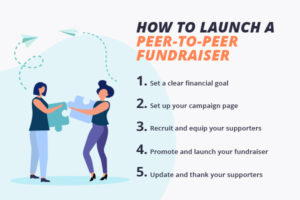
88% of consumers trust suggestions from friends and family more than traditional advertising, according to a Nielson report. This statistic speaks to the power of social proof, which your university or organization can tap into to cultivate more trust and more donations.
In the context of alumni fundraising, this means that it can be much more effective to tap into alumni support networks to facilitate fundraising on your organization’s behalf rather than reaching out directly. This strategy, known as peer-to-peer fundraising, also benefits your organization by connecting current members to alumni and building life-long relationships.
In this guide, we’ll discuss the basics of peer-to-peer fundraising and determine how you can incorporate it into your organization’s strategy to experience alumni fundraising success.
Peer-to-Peer Fundraising Basics
Peer-to-peer fundraising, also known as P2P fundraising, is a strategy that asks individual, volunteer fundraisers to create and promote donation pages for your cause. It includes a personalized and social approach where individuals facilitate and advertise your fundraiser.
Typically, organizations will recruit supporters with large networks to launch personalized campaign pages. Then, these supporters will reach out to their friends and family to collect donations on your behalf. Fundly’s donation guide highlights peer-to-peer fundraising as an effective strategy for the following reasons:
- Inherent trust. Peer networks of friends, families, and coworkers all have common ground with your supporters already. While building this inherent trust with new donors typically takes time, you can earn donations faster by leveraging these existing relationships.
- Instant access. It’s easier to ask for donations from people who are in your immediate vicinity or with whom you keep up regularly. Supporters don’t engage with organizations as much as they do with their networks, so using these relationships to your advantage can increase reach.
- Shared values. Often, friends and family agree on charitable causes to support. This makes inviting them to a meaningful event, asking for financial support, or simply raising awareness much easier.
Because peer-to-peer fundraising relies on supporter networks to launch and sustain funding, organizations don’t have to worry about selecting the perfect fundraising product to sell or ironing out the details of a fancy gala.
Although not mandatory, many peer-to-peer fundraisers are combined with popular events such as charity runs, bike-a-thons, or even celebratory birthday fundraisers. That’s the great part about peer-to-peer fundraising—it’s flexible enough to adapt to any cause or event.
Peer-to-Peer Fundraising vs Crowdfunding
Although similar, peer-to-peer fundraising and crowdfunding have distinct differences worth defining. Crowdfunding involves an organization creating a centralized donation page with a broader, more direct public appeal. These campaigns can also be rewards-based and are usually conducted with a strict timeline.
On the other hand, peer-to-peer fundraising campaigns involve a more network-driven approach in which supporters create their own online fundraising pages to share with friends and family. This makes peer-to-peer fundraising a perfect fit for tight-knit alumni networks that are more engagement or community-focused.
How to Launch a Peer-to-Peer Fundraiser
Refer to these five quick steps for launching your peer-to-peer fundraiser:

- Set a financial goal by clearly outlining what you aim to achieve. This should include a financial target that is informed by your previous fundraising campaigns and donor analytics.
- Set up your main campaign page to prioritize user-friendliness, customization options, and integration capabilities with social media and your existing donor management system.
- Recruit supporters who will serve as your campaign’s initial fundraisers. Equip them with fundraising pages, tips for sharing their stories, and strategies for reaching out to their networks.
- Promote and launch your fundraiser by hosting an event or announcing the campaign online. Use multiple channels such as email marketing, social media, and your organization’s website in addition to individual donation pages.
- Update and thank your supporters by keeping them in the loop when you’ve reached fundraising milestones. Express gratitude during and after your campaign for every donation, no matter the size.
As you can see, pulling off this fundraising idea depends on your ability to reach social networks. That said, you need to do everything you can to make sure your peer-to-peer fundraising software and campaign materials are ready to use once the campaign goes live. This may mean testing technology and resolving issues proactively so that donors can experience a hassle-free donation process.
Peer-to-Peer Alumni Fundraising Best Practices
There are a few peer-to-peer strategies you can use to really harness the power of your alumni’s reach and impact. Implementing these best practices will give your campaign an extra edge to go above and beyond the basic peer-to-peer fundraising steps:
- Engage passionate alumni leaders. Refer to your CRM to identify and ask passionate alumni volunteers to take charge of your peer-to-peer fundraising efforts. Equip them with the necessary information such as an example fundraising page, an explanation of where the funds will go, and suggested promotional channels.
- Create branded and personalized fundraising pages. Use a reputable online fundraising platform to host your donation pages. Encourage your alumni volunteers to brand the pages to your organization while making it their own. For example, a school raising money for its music department might suggest volunteers add testimonials about their musical program experience.
- Utilize matching gifts. According to Double the Donation’s alumni fundraising guide, an estimated $6-$10 billion in matching gift funds goes unclaimed every year. Claim more matching gifts by integrating a matching gift option into your online fundraising pages. Simply provide clear instructions or an FAQ section on how to submit a matching gift request to one’s employer directly on the page.
- Leverage ready-made tools. Peer-to-peer fundraisers go more smoothly with ready-made templates and pages you can point your supporters to. Graphics, social media post templates, and content ideas can make sharing and getting involved easy and consistent for every supporter.
- Foster friendly competition. If your organization wants to raise money for separate causes, you could host a competitive peer-to-peer fundraiser where teams compete to see which cause can raise the most funds. Use leaderboards, incentives, and rewards to drive support until the fundraiser comes to a close.
By practicing the above strategies, you can be confident that your fundraising idea will be a hit. Remember to analyze your fundraising performance as your campaign progresses. This way, you can course-correct by providing additional support to fundraisers, adjusting promotional messages, or overcoming any challenges that may arise.
Peer-to-peer fundraising is an excellent method for engaging your alumni networks, but it relies on their active participation. Be sure to provide fundraisers with the support they need and thank them for their participation so they feel appreciated. For instance, you may include a peer-to-peer fundraising best practice guide along with your contact information so they can fundraise confidently.
